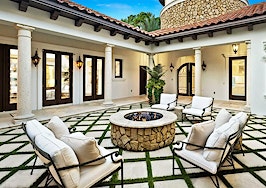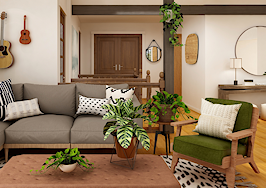Before selecting colors, floor and backsplash tiles, and hardware for cabinets, and before considering appliance models, sizes or finishes, a kitchen — whether it’s brand new or a renovation project — must function as a workspace.
With the endless choices and combinations of materials, the number of decisions involved in kitchen planning can be overwhelming. Simple rules of design to keep in mind are balance and symmetry, focal points, scale and proportion. These are things a kitchen designer can assist with using computer drawings and sketches.
No matter how much imagination your clients bring to their kitchen design process and how extensive their research is, the kitchen in the home they’re listing and selling should be appropriate for the space and the type of house.
As a real estate agent, knowing a few terms that apply to kitchen descriptions will definitely come in handy. Beyond “eat-in kitchen” and “chef’s kitchen,” there are six different styles that define the space and will impress your sellers and buyers.
There is no one ideal kitchen plan or layout for every buyer or for each apartment or house. All plans can be modified or refined to meet the needs of the buyer. However, a carefully planned and executed kitchen will be an invaluable tool in selling a home for the maximum price.
Kitchens require plumbing, electricity and a gas line if a gas stove will be used. In an existing structure, the location of the sink and refrigerator (if it’s going to have an ice maker and water access through the door) will be limited to the plumbing lines.
The stove will have some leeway, based on where the gas line is located. Electrical access is more flexible, as the electrician can add lines wherever needed to accommodate appliances.
It is appropriate at this time to mention the classic kitchen “triangle” planning rule of thumb. As an agent, you view multiple kitchens in floor plans and in-person showings with buyers and sellers. Once you acquaint yourself with the idea of the work triangle, you are forever sensitized.
Food originates at the pantry or refrigerator in the kitchen and is then moved to the sink area for preparation, and then to the stove for cooking. The space between these three areas, measured in footsteps, determines the efficiency — and desirability — of the kitchen.
1. The one-wall kitchen
No explanation is necessary here. The name describes the appliances, cabinets and counters along one wall at the end of a living room, dining room or great room. Typically, the one-wall kitchen is found in smaller kitchens, and it’s simple, straightforward and efficient.
Depending on the location of the plumbing line, the sink in the middle, between the stove and refrigerator, will enable easy cooking. Workspace on either side of the sink will allow for meal prep and cleanup, and if the one-wall kitchen is long enough, more than one cook can work simultaneously without colliding.

Photo by Sidekix Media on Unsplash
Storage will be vertical, maximizing wall space and under-counter cabinets and drawers. This type of kitchen is popular in stark, modern construction, with the kitchen finishes blending in seamlessly with the rest of the room scheme.
2. The galley kitchen
Also popular in small spaces (and extremely efficient for a single cook), the galley kitchen consists of two rows of cabinets and appliances facing each other with a passage in between.
Essentially doubling the size of the one wall kitchen, the galley eliminates deep corner cabinets with storage that’s inefficient. If you encounter a galley kitchen as an agent, make sure to open cabinet doors, the dishwasher, oven and refrigerator to see if the doors collide and if there’s adequate space to move around.

Photo by Jean-Philippe Delberghe on Unsplash
A well-planned galley kitchen will allow all of the kitchen appliances to open without interfering with each other. Though they can be efficient, I’ve been in galley kitchens where I had to step out of the space in order to open the oven door — not the best plan.
3. The L-shaped kitchen
Whether it’s small or large, the L-shaped kitchen is efficient in its design. The layout involves two perpendicular walls of cabinetry, which form the letter “L.” Using the corner efficiently for storage or appliance placement will help maximize this type of plan. An L-shaped kitchen provides open traffic and easy access to all of the kitchen’s features.

Photo by Sidekix Media on Unsplash
4. The U- shaped kitchen
For larger kitchens, the U-shaped plan utilizes three walls for storage and food prep, and even staging areas for plating and serving. Remember that the three points of the work triangle are the refrigerator, sink and stove. In a U-shaped layout, each of the three walls can be dedicated to its own purpose.

Photo by Sidekix Media on Unsplash
A U-shaped kitchen is ideal for multiple cooks or family cooking experiences. The U-shape can be continuous or interrupted by doors or passageways. It’s important to be aware of traffic flow and how people entering the kitchen will be crossing between counters and work areas to avoid collisions and traffic jams.
5. The island kitchen
No, we’re not talking about a kitchen in the tropics. Instead, I’m referring to a freestanding counter space or “island” which can often contain a sink, stove or prep area. The island kitchen is usually found in open-plan homes with a generously sized kitchen.
Islands can be great centers for socializing in the kitchen and may even have a space for counter-height bar seating. They’re great for buffets or bars when hosting a party, and they’re often the reason people seem to gravitate toward the kitchen.

Photo by Creatv Eight on Unsplash
Again, traffic flow is key to prevent bottlenecks or dead ends. You don’t want people to feel trapped. An island in a well-designed kitchen is always a sign of luxury and spaciousness.
6. The peninsula kitchen
In a space that does not lend itself to an island, a peninsula or counter that’s attached to a wall or cabinet is another option. Also an option for dining at bar height, socializing or food prep, a peninsula maximizes space and eliminates unnecessary steps.
A peninsula kitchen, which is attached to a wall, is best in a medium-sized kitchen. The peninsula may or may not have wall cabinets above, depending on the amount of storage required. Eliminating wall cabinets above will create a more open feel in the room, inviting family and guests to congregate.

Photo by Sidekix Media on Unsplash
A final category I call the “hodgepodge” is a combination of one or more of the above floorplans. Kitchens invite innovation and an adaption to new appliances or lifestyles. A one-wall kitchen can benefit from the addition of a movable island or work surface on wheels. A galley kitchen can be turned into a U-shaped kitchen with the addition of a third wall.
As a real estate agent, it’s crucial to develop the ability to think critically and creatively, visualizing the potential for a kitchen that will help the buyer upgrade and improve the existing space. By becoming well-versed in these simple kitchen layouts and styles, you can establish your authority and help create a dialogue with your buyer — both of which will lead to more closed sales.
Gerard Splendore is a licensed associate real estate broker with Warburg Realty in New York. Connect with him on LinkedIn.













